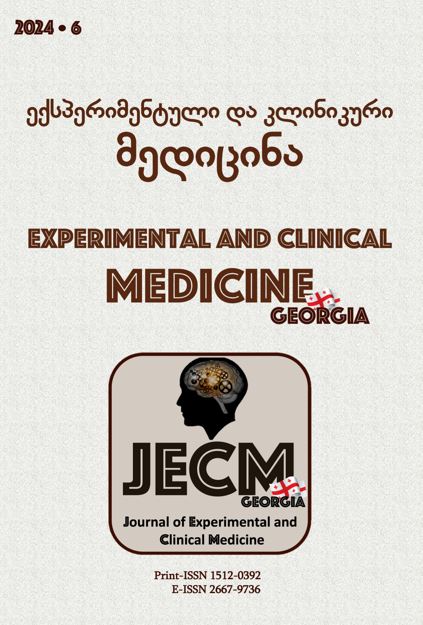საგზაო უსაფრთხოება და დემენცია: გამოწვევები აღმოსავლეთ პარტნიორობის ქვეყნებისთვის
DOI:
https://doi.org/10.52340/jecm.2024.06.13საკვანძო სიტყვები:
Road Safety, Dementia, Challenges, Eastern Partnership Countriesანოტაცია
სტატიაში განხილულია დემენციის გავლენა საგზაო უსაფრთხოებაზე და ხანდაზმული მძღოლების მიერ მართვასთან დაკავშირებული საერთაშორისო რეგულაციები. მოსახლეობის დაბერება, დემენციის პრევალენტობის მატება და საგზაო უსაფრთხოება კიდევ უფრო მასშტაბურ და მწვავე ხასიათს შეიძენს აღმოსავლეთ პარტნიორობის ქვეყნებში. არსებულ გამოწვევებზე საპასუხოდ წარმოდგენილია საერთაშორისო გაიდლაინების შესაბამისი რეკომენდაციები. მნიშვნელოვანია მოსახლეობაში საგზაო უსაფრთხოების და დემენციის შესახებ ცნობიერების ამაღლება და მართვის უნარებზე დემენციის ზემოქმედების შესახებ განათლების ხელშეწყობა; ასევე ჯანდაცვის სისტემების გაძლიერება, სამედიცინო პერსონალისთვის სპეციფიკური ტრენინგების უზრუნველყოფა, რაც ხელს შეუწყობს ასაკოვან მძღოლებში კოგნიტურ დარღვევებთან დაკავშირებული პრობლემის ადრეულ გამოვლენას და საგზაო უსაფრთხოების რისკების შემცირებას. მნიშვნელოვანია ჯანდაცვის და სატრანსპორტო სექტორის მჭიდრო თანამშრომლობა საგზაო უსაფრთხოების რელევანტური ინტერვენციების (როგორიცაა მაგ., ასაკის შესაბამისი ლიცენზირება კოგნიტური ჯანმრთელობის სავალდებულო შეფასებით და ხანდაზმული მძღოლების ფიზიკური და კოგნიტური უნარების პერიოდული შეფასება) დასანერგად. საერთაშორისო თანამშრომლობის გაძლიერება ხელს შეუწყობს ჯანდაცვის სექტორსა და საგზაო უსაფრთხოებაში რეგულაციების საერთაშორისო სტანდარტებთან დაახლოებას და საგზაო უსაფრთხოების ვალდებულებების გლობალურ დონეზე უზრუნველყოფას.
Downloads
წყაროები
Albert G, Lotan T, Weiss P, Shiftan Y. The challenge of safe driving among elderly drivers. Health Technol Lett. 2018 Jan 26;5(1):45-48.
Allan CL, Behrman S, Baruch N, et al. Driving and dementia: a clinical update for mental health professionals. BMJ Ment Health 2016; 19:110-113.
Bennett JM, Chekaluk E, Batchelor J. Cognitive Tests and Determining Fitness to Drive in Dementia: A Systematic Review. J Am Geriatr Soc. 2016 Sep; 64(9):1904-17.
Camilleri L, Whitehead D. Driving Assessment for Persons with Dementia: How and when? Aging Dis. 2023 Jun 1;14(3):621-651.
Cohen JA, Verghese J. Gait and dementia. Handb Clin Neurol. 2019;167:419-427.
European Commission. Older Driver. 2015. Available from: https://road-safety.transport.ec.europa.eu/system/files/2021-07/ersosynthesis2015-olderdrivers25_en.pd
Iverson DJ, Gronseth GS, Reger MA, Classen S, Dubinsky RM, Rizzo M., Quality Standards Subcommittee of the American Academy of Neurology. Practice parameter update: evaluation and management of driving risk in dementia: report of the Quality Standards Subcommittee of the American Academy of Neurology. Neurology. 2010 Apr 20; 74(16):1316-24.
Lindstrom-Forneri W, Tuokko HA, Garrett D, Molnar F. Driving as an everyday competence: A model of driving competence and behavior. Clin Gerontol. 2010; 33(4), 283-297.
McNamara S, Jandu JS, Mohanaselvan A, et al. Cognitive Decline and Driving Evaluation in the Elderly. [Updated 2024 Sep 11]. In: StatPearls [Internet]. StatPearls Publishing; 2024 Jan-Available from: https://www.ncbi.nlm.nih.gov/books/NBK569418/
Meuleners LB, Ng J, Chow K, et al. Motor vehicle crashes and dementia: a population-based study. J Am Geriatr Soc 2016;64:1039–45.
Molnar FJ, Simpson CS. Approach to assessing fitness to drive in patients with cardiac and cognitive conditions. Can Fam Physician. 2010; 56:1123-9.
The Global Impact of Demetia: An analysis of prevalence, incidence, costs and trends. ADI 2015. Available from: https://www.alzint.org/u/WorldAlzheimerReport2015.pdf
Siren A. et al. Driver licensing legislation. Consol Work package 5.1 Report. Available from: www.consolproject.eu
Toepper M, Falkenstein M. Driving Fitness in Different Forms of Dementia: An Update. J Am Geriatr Soc. 2019 Oct;67(10):2186-2192.
Global status report on the public health response to dementia. Geneva: WHO, 2021. Available from: https://iris.who.int/bitstream/handle/10665/344701/9789240033245-eng.pdf
Wolfe PL, Lehockey KA. Neurophysiological assessment of driving capacity. CAN. 2016; 31: 517-529.






